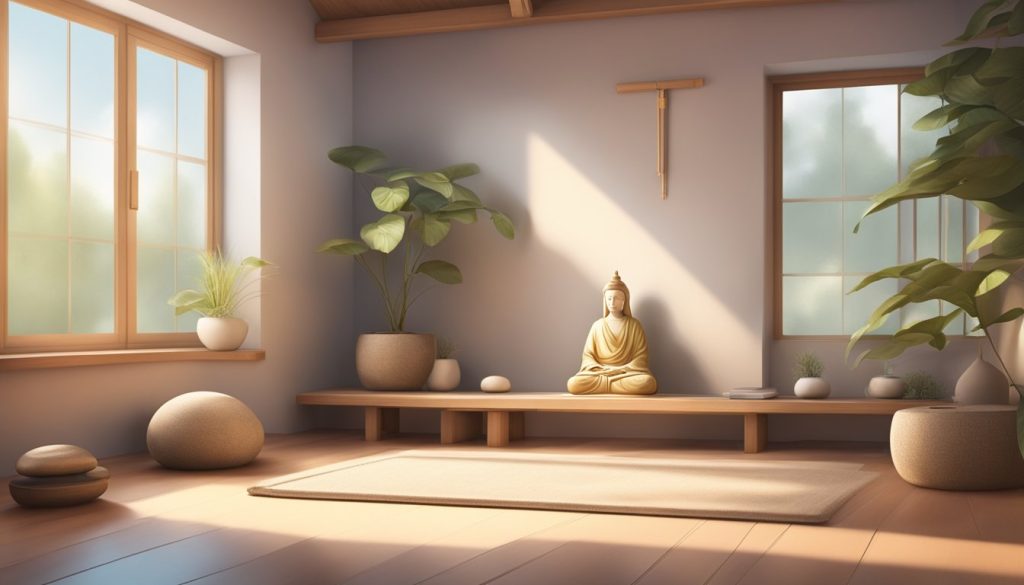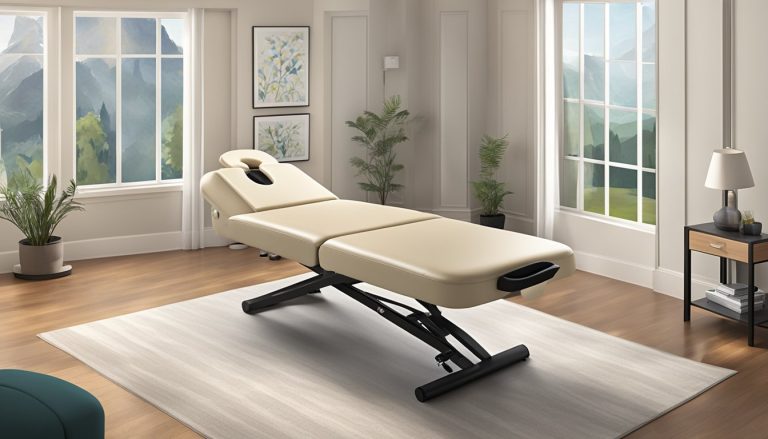Essential Meditation Furniture: Choosing Comfort for Mindfulness Spaces
Creating a dedicated space for meditation can significantly enhance the practice by fostering a sense of serenity and focus.
Essential meditation furniture plays a vital role in this endeavour, allowing for a comfortable and ergonomic setup that supports mindfulness and mental health.
I’ve found that the right furniture not only adds to the aesthetics of the meditation space but also encourages proper posture, which is crucial for prolonged meditation sessions.

When I select meditation furniture for my own space, comfort and posture are at the forefront of my considerations.
The pieces chosen need to support a relaxed yet alert state conducive to meditation.
Items such as meditation chairs or cushions are especially designed to keep the spine straight yet relaxed, which is essential for both focus and health during meditation.
It’s important for the furniture to be unobtrusive and harmonise with the overall tranquillity of the space, ensuring that my meditation experience is both physically and mentally rewarding.
Key Takeaways
- Furniture can enhance meditation by supporting comfort and correct posture.
- The ergonomics of meditation furniture contribute to mental and physical health during practice.
- Maintaining meditation furniture ensures the longevity of the items and the quality of practice.
Selecting the Right Meditation Furniture
I find that creating a space conducive to mindfulness starts with choosing the right meditation furniture. Here, I’ll guide you through the different types and essential factors to consider to ensure your meditation practice is as comfortable and supportive as possible.
Understanding Different Types of Meditation Furniture
When I think about meditation furniture, the variety is astounding. Each type serves a unique purpose and supports various postures and preferences:
- Meditation Cushions (Zafus): Round or crescent-shaped, filled with buckwheat or kapok for firm support.
- Zabutons: Flat, mat-like cushions providing insulation and comfort for knees and ankles.
- Meditation Benches: Wooden or bamboo, often with a slight incline to maintain spine alignment.
- Meditation Chairs: Some with back support, tailored to reduce strain during longer sessions.
- Yoga Mats: Providing a non-slip surface for those who incorporate yoga into their practice.
It’s important for me to choose the item that best aligns with my posture and the level of comfort I need.
Factors to Consider When Choosing Furniture
When selecting meditation furniture, I consider several key factors:
- Comfort & Back Support: Essential for maintaining posture and focus during meditation. Type Comfort Level Back Support Cushions High Low Benches Moderate Low Chairs High High
- Material: I seek out materials that feel good against my skin and are durable. Options include organic cotton or eco-friendly materials, which are kind to the planet. Material Durability Eco-Friendly Cotton Moderate Yes Bamboo High Yes Synthetic High No
- Size: Should match my body type and the available space in my meditation area. Type Size Consideration Cushions Body + Space Size Benches Height-Compatible Chairs Fits in Meditation Space
- Features: Some furniture may come with additional features such as being foldable for easy storage or having removable parts for portability. Feature Usefulness Foldable Easy Storage Removable Parts Portability
Designing Your Meditation Space
Creating a meditation space in my home has been a transformative experience. It’s a personal retreat where I can unwind and centre my thoughts. Here’s how I designed mine.
Choosing the Proper Layout
When I first considered the layout for my meditation space, comfort was paramount. I needed a design that would support my back and encourage proper posture during meditation. Here’s what I focused on:
- Meditation Chair or Cushion: I opted for a meditation chair with a supportive backrest, ensuring comfort during prolonged sessions. The chair’s features, like adjustable seating and a tilt function, were important for maintaining a gentle, supportive angle for my spine.
- Cushion Material: For floor seating, like a Zen master might prefer, I chose a high-density cotton cushion. It provided enough support to keep my posture aligned without placing undue pressure on my hips or knees.
Incorporating Natural Elements
Meditating amidst natural elements enhances the peaceful aura of the space. This was how I introduced nature into my meditation area:
- Plants: A few potted plants placed around the room not only purified the air, but also added a sense of life and tranquillity. Easy-to-care-for species like snake plants require minimal attention but have a great impact.
- Natural Light: Utilising windows effectively in the layout of my apartment allowed for an abundance of natural light. This uplifted the energy of the space and reduced the need for harsh artificial lighting.
Designing my meditation space was about crafting a peaceful sanctuary where every element served a purpose, from a comfortable chair to the inclusion of nature’s touch through plants and sunlight.
Focus on Comfort and Posture
When I meditate, two things matter greatly: comfort, which sustains my practice, and posture, which enhances the meditative experience.
Achieving Comfort through Supportive Furniture
My approach to achieving comfort during meditation centres on using supportive furniture that offers necessary back support.
I’ve found that meditation chairs with dense foam can be extremely comfortable, and they do wonders for preventing discomfort in my back. Ensuring that the chair has an ergonomic design also contributes greatly to lower back support.
When I consider portability, folding floor chairs stand out. They are convenient for retreats and impromptu sessions.
- Key features I look for in a meditation chair:
- Dense foam for cushioning
- Ergonomic design for back and lower back support
- Portability for use in different settings
Enhancing Posturial Alignment
The right furniture aids in maintaining proper posture, which in turn can help in achieving balance and alignment essential for meditation.
For example, an ergonomic kneeling chair has been integral to my practice as it helps align my back and shoulders correctly, taking pressure off my knees, ankles, and feet. It elevates the hips and angles them forward to encourage a natural spine position.
- Essential aspects of furniture for posture:
- Height and angle should promote alignment of the spine
- Features that support the knees, ankles, and feet to prevent strain
Meditation cushions are another staple in my practice; they’re a simple yet effective way to enhance my posture. I select cushions that are thick enough to offer balance and comfortable seating. Firm support is as crucial as comfort to prevent posture from slumping during long sessions.
Meditation for Specific Needs

When I design my meditation space, I always consider furniture that caters to specific health and medical needs. Comfort and support during mindfulness practice are paramount, especially for those of us managing pain or medical conditions.
Solutions for Pain Relief
For meditators like me who experience pain, especially in the back or knees, choosing the right meditation furniture can make a world of difference. Meditation benches are a great solution, as they support a kneeling position that can take the pressure off the joints.
I always look for benches with a slight incline, which helps to maintain a natural spine alignment, contributing to better blood pressure regulation during practice. My top picks always have a memory foam cushion; it adapts to my body’s shape, providing personalised comfort and aiding in relaxation.
Weight capacity is a factor I never overlook; it’s essential to ensure that the bench can comfortably support my weight without any risk of collapse.
A bench that’s easy to clean is also a must, as it helps maintain a hygienic space conducive to clear-headed meditation.
Considering Meditators with Medical Requirements
For those of us with medical conditions, finding the right meditation chair is crucial. My go-to is a comfortable meditation chair that helps to reduce strain on my body by providing proper support and easily adjustable features to cater to individual requirements. Features like adjustable backrests or seat angles can be particularly helpful.
I also consider materials: a chair with a washable cover or made from non-irritating fabrics is a priority, especially for anyone with skin sensitivities or allergies.
Having a chair that’s both comfortable and appropriate for my health needs means that I can focus on my mindfulness practice without additional stress or discomfort. It’s all about creating a peaceful retreat for the body and mind.
Additional Considerations for Meditation Furniture
When selecting meditation furniture, I consider both the aesthetic influence on mindfulness and functionality coupled with maintenance. These factors greatly influence the effectiveness and longevity of one’s meditation practice.

Aesthetic Influence on Mindfulness
I find that the style and aesthetics of meditation furniture can significantly impact my state of mindfulness. Tranquility and inner peace are cultivated in a space that resonates with a calming presence and minimises distractions.
For example, colours inspired by nature can enhance harmony and reduce anxiety.
Utilities like the Waytrim Adjustable Meditation Chair and the Alexia Meditation Seat have a modern appeal that can complement the surrounding space.
I aim for a cohesive look that fosters a quiet atmosphere and enhances my awareness.
Functionality and Maintenance
In considering functionality, I focus on the furniture’s ability to support my meditation position and maintain the health of my spine.
Portability also matters to me for situations where I might wish to change my meditation spot.
For example, chairs like the Back Jack Floor Chair and the Friends of Meditation Chair offer robust support and can be easily moved.
The materials of meditation furniture are equally crucial; I prefer eco-friendly materials like recycled cotton, which are not only better for the environment but often more easy to clean.
I also look at the weight capacity to ensure durability, and I don’t forget to check reviews for user experiences. Brands like Gaiam Rattan Meditation Chair have generally positive feedback for their design and comfort, which solidifies my confidence in the investment.
Purchasing and Caring for Your Meditation Furniture

When I choose meditation furniture, my focus is on both affordability and durability. I prefer items that offer good back support and fit within my sanctuary comfortably.
Making a Budget-Conscious Choice
I start by setting a sensible budget, which helps me assess the range of furniture I can afford without compromising on quality. Meditation benches and yoga mats are essentials.
When choosing a bench, I look for designs that provide good back support and are made from sustainable materials. For yoga mats, options vary from PVC to eco-friendly materials like cotton or linen. Here’s a breakdown of what I consider:
- Meditation Bench: Ensures a good posture. I opt for benches made of solid wood or bamboo for longevity.
- Yoga Mats: I select mats based on the type of practice. Thick, cushioned mats made of natural rubber or jute are preferable for comfort and ethical reasons.
Maintaining Your Meditation Furniture
Keeping my meditation space as a sanctuary requires regular care for the furniture I have chosen. Here’s how I ensure they last as long as possible:
- Cleaning Regularly: Whether it’s a bench or mat, I make sure to clean them after every use with a mild cleaner to prevent build-up of sweat and dust.
- Material Care: For furniture made of materials like cotton, linen, or wood, I use specific cleaning solutions that are gentle and preserve the material’s integrity. For example:
- Cotton/Linen: A soft cloth with warm water and mild detergent works best.
- Wood/Bamboo: I wipe it down with a damp cloth and occasionally treat it with a wood-friendly polish.
In essence, I choose meditation furniture that fits my budget and my physical needs, making sure they are made from eco-friendly materials that won’t harm my little sanctuary. Then, I commit to a simple maintenance routine to ensure they remain a comfy part of my practice for years to come.
Frequently Asked Questions
In this section, I’ll answer some common questions about meditation furniture—focusing on how it can enhance your practice and support your body.
What features should I look for in a meditation chair with back support?
When choosing a meditation chair with back support, I recommend considering adjustability in height, tilt, and lumbar support.
This ensures the chair can be tailored to your body, promoting better posture and comfort during meditation.
How can a meditation floor chair enhance my practice?
A meditation floor chair can provide essential support and comfort for your lower back and hips, which are crucial if you’re sitting for long periods.
With various adjustable angles, it allows me to find the ideal position for my meditation practice.
Can ergonomic meditation chairs alleviate discomfort during meditation?
Absolutely, ergonomic meditation chairs are designed to reduce strain on the body.
These chairs often offer proper cushioning and support to help alleviate discomfort, especially in the back and legs, during prolonged periods of meditation.
Is it beneficial to use a specialised chair for meditation if I have knee issues?
Using a specialised meditation chair can be very beneficial if you have knee issues.
Chairs designed with proper height and cushioning can help reduce pressure on the knees, making meditation more accessible and comfortable for me.
Which type of chair is recommended for maintaining a good posture while meditating?
For maintaining good posture, I’d suggest a chair with a slightly angled seat to encourage pelvis rotation forward, supporting the natural curve of the spine.
This helps in maintaining an erect posture without causing strain.
In what ways does the furniture in a meditation room enhance the meditation experience?
The right furniture in a meditation room creates a conducive environment for practice.
I find that comfortable and supportive chairs help maintain focus and reduce distractions, while the setting itself promotes a calm and serene atmosphere.







